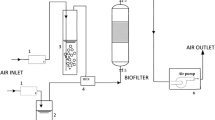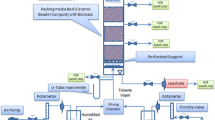Abstract
The removal of toluene from an experimental gas-stream was studied in an industrial biofilter filled with poplar wood bark. Toluene degradation, approximately 85% through the operating period, resulted in low levels of toluene in the off-gas effluent. For a toluene load of 6.7 g m-3 h-1 the elimination capacity of the biofilter was found to be 6.0 g m-3 h-1. Toluene removal was due to biodegradative activity of microorganisms in the filter bed; the most probable number counts of toluene degraders increased from 2.4×102 to 6.4×107 MPN/g dry packing material in about seven months of air-toluene supply. The degradative capacity of a Burkholderia (Pseudomonas) cepacia strain, isolated from the biofilter material, as an example of the effectiveness of microbial toluence removal was tested in batch culture. The microorganism degraded completely 250 ppm of toluence supplied as sole carbon source in 24 hours. The high performance demonstrated for a long period and the mechanical and physico-chemical stability of the biofilter favour its use in industrial full-scale off-gas control.
Similar content being viewed by others
References
Arcangeli JP & Arvin E (1992) Toluene biodegradation and biofilm growth in a aerobic fixed-film reactor. Appl. Microbiol. Biotechnol., 37: 510–517.
Bergey's Manual of Systematic Bacteriology (1984) Section 4. NRKrieg, JGHolt (Eds). Baltimore, The Williams & Wilkins Co.
Bergey's Manual of Systematic Bacteriology (1986) Sections 12. Snearth PHA, Mair NS, Sharpe ME, Holt JG (Eds). Baltimore, The Williams & Wilkins Co.
Douglass RH, Armstrong JM & Korreck WM (1991) Design of a packed column bioreactor for on-site treatment of air stripper off-gas. In: Hinchee RE & Olfenbuttel RF (Eds) On-site Bioreclamation, Process for Xenobiotic and Hydrocarbon Treatment (pp 209–225). Batelle Memorial Institute, Columbus, Ohio, Butterworth-Heinemann.
Dragt AJ (1992). In: Dragt AJ, VanHam J (Eds) Biotechniques for Air Pollution Abatement and Odour control Policies (pp 3–9) Elsevier, Amsterdam.
Fukuyama J & Honda A (1976) Removal of malodorous gases containing aromatic hydrocarbons by activated sludge. Taiki Osen Kenkyu. 11: 386.
Groenestijn Jw & Hesselink GM (1993) Biotechniques for air pollution control. Biodegradation 4: 283–301.
Hirai M, Ohtake M & Shoda M (1990) Removal kinetics of hydrogen sulfide, methanethiol and dimethyl sulfide by peat biofilter. J. Ferment. Bioeng. 70: 334–339.
Hyman MR, Sansome-Smith AW, Shears JH & Wood PM (1985) A kinetic study of benzene oxidation to phenol by whole cells of Nitrosomonas europea and evidence for further oxidation of phenol to hydroquinone. Arch. Microbiol. 143: 302–306.
Kunz DA & Chapman PJ (1981) Catabolism of pseudocumene and 3-ethyltoluene by Pseudomonas putida (arvilla) mt-2: evidence for new function of the TOL (pWWO) plasmid. J. Bacteriol. 146: 179–191.
Leson G & Winer AM (1991) Biofiltration: an innovative air pollution control technology for VOC emissions. J. Air Waste Manage. Assoc. 41: 1045–1054.
Liu PKT, Gregg RL, Sabol HK & Barkley N (1994) Engineered biofilter for removing organic contaminants in air. Air & Waste 44: 299–303.
Ottengraf SPP & van denOever AHC (1983) Kinetics of organic compound removal from waste gases with a biological filter. Biotechnol. Bioeng. 25: 3089–3102.
Pedersen AR & Arvin E (1995) Removal of toluene in waste gases using a biological trickling filter. Biodegradation 6: 109–118.
Pochon J & Tardieux P (1962) Techniques d'Analyse en Microbiologie du Sol. In: De la Tourelle, St. Mandè (Eds) Collection ‘Techniques de Base’ (pp 59–62).
Pomeroy RD (1982) Biological treatment of odorous air. J. Wat. Pollut. Control Fed. 54: 1541–1545.
Schindler I & Friedl A (1995) Degradation of toluene/heptane mixtures in a trickling-bed bioreactor. Appl. Microbiol. Biotechnol. 44: 230–233.
Shareefdeen Z & Baltzis BC (1994) Biofiltration of toluene vapor under steady-state and transient conditions: theory and experimental results. Chem. Engng. Science. 49: 4347–4360.
Smith MR (1990) The biodegradation of aromatic hydrocarbons by bacteria. Biodegradation 1: 191–206.
VanLangenhove H, Wutys E and Schamp N (1986) Elimation of hydrogen sulphide from odorous air by a wood bark biofiltration. Wat. Res. 20: 1471–1476.
Weber FJ & Hartmans S (1995) Use of activated carbon as a buffer in biofiltration of waste gases with fluctuating concentrations of toluene. Appl. Microbiol. Biotechnol. 43: 365–369.
Wolff F (1992) Biologische abluftrenigung mit einem intermittierend befeuchteten tropfkörper. In: Dragt AJ & van Ham J (Eds) Biotecniques for Air Pollution Abatement and Odour Control Policies (pp 49–62). Elsevier Science Publishers B.V..
Author information
Authors and Affiliations
Rights and permissions
About this article
Cite this article
Andreoni, V., Origgi, G., Colombo, M. et al. Characterization of a biofilter treating toluene contaminated air. Biodegradation 7, 397–404 (1996). https://doi.org/10.1007/BF00056423
Accepted:
Issue Date:
DOI: https://doi.org/10.1007/BF00056423




